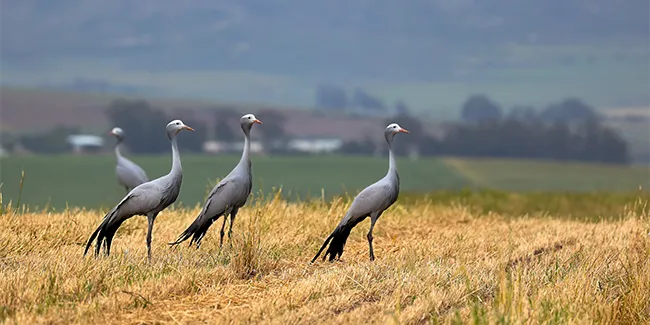Urgent conservation efforts to save South Africa's Blue Crane in the Western Cape and Karoo

The Endangered Wildlife Trust and International Crane Foundation launch renewed conservation efforts to protect South Africa's iconic Blue Crane as its population faces alarming declines in the Western Cape and Karoo.
Image: Supplied
With the dwindling number of South Africa’s national bird, the Blue Crane, in the Western Cape and Karoo, the Endangered Wildlife Trust (EWT) through its partnership with the International Crane Foundation (ICF) is ramping up its conservation efforts in these areas.
This comes after decades of successful conservation interventions yielded positive results in KwaZulu-Natal and the Northern Cape.
EWT spokesperson Eleanor Momberg said attention is now being directed to populations in the Western Cape, with the same positive outcomes being targeted.
Momberg said Blue Cranes are endemic to South Africa, with a small population found in Namibia, making these the world’s most range-restricted crane.
“There are less than 30,000 of these birds left in the world,” she said.
To commemorate Heritage Month and the upcoming Heritage Day on September 24, these partner organisations are expanding their efforts to protect the future of Blue Crane populations in the Western Cape.
This will be achieved by intensifying their focus on habitat restoration alongside communities and farmers, and by addressing the dangers posed by energy infrastructure.
Momberg said until 2010 Blue Crane numbers were increasing and healthy in the Karoo and Western Cape.
“However, a recent PhD study supported by the EWT/ICF Partnership reveals that numbers have subsequently been declining in these areas, especially in the Overberg where counts have dropped by 44% between 2011 and 2025,” she said.
Momberg further explained that since 1994 the EWT/ICF partnership has been committed to Blue Crane conservation in South Africa, running projects in the grasslands, Karoo and Western Cape.
She said over the last 10 years the majority of the applied crane conservation work has focused on the Drakensberg region where Blue Cranes have historically faced steep declines.
“With consistent conservation action, including natural habitat protection, powerline impact mitigation and community projects, Blue Crane numbers are now slowly increasing, testimony to the success of our conservation activities,” she said.
The declining numbers in the Western Cape and Karoo have sparked the need for a renewed conservation effort underpinned by a multi-stakeholder conservation plan which was developed with the help of the Conservation Planning Specialist Group, gathering inputs from NGOs, industry, landowners, communities and government.
The conservation plan is built on four core pillars, each designed to ensure the survival and thriving of Blue Cranes.
These include habitat protection by expanding successful Drakensberg efforts to the Western Cape and Karoo, mitigating energy infrastructure impacts by partnering with energy suppliers to reduce powerline collisions, promoting crane-friendly agriculture by collaborating with farmers to address poisoning and breeding disturbances, and implementing rigorous research and monitoring to track population changes and assess strategy effectiveness.
“The implementation of this four-pronged approach creates certainty for the EWT/ICF that we can reverse the decline in the Blue Crane populations in the Karoo and Western Cape, as we have done in the Drakensberg region,” said Momberg.
She stated that the EWT remains committed through the implementation of its future fit strategy to working with partners throughout Africa to ensure the survival of crane species, particularly the Blue Crane, Grey Crowned Crane and Wattled Cranes.
“As South Africa’s National Bird, the Blue Crane (Anthropoides paradiseus) is an important element of the country’s natural heritage, serving as a flagship for conservation in agricultural landscapes, from the rolling grasslands of KwaZulu-Natal to the expansive plains of the Karoo, to the patchwork of crops and renosterveld in the Western Cape,” added Momberg.
karen.singh@inl.co.za